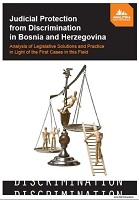Judicial Protection from Discrimination in Bosnia and Herzegovina - Analysis of Legislative Solutions and Practice in Light of the First Cases in this Field
Judicial Protection from Discrimination in Bosnia and Herzegovina - Analysis of Legislative Solutions and Practice in Light of the First Cases in this Field
Author(s): Adrijana Hanušić
Contributor(s): Edin Hodžić (Editor), Kanita Halilović (Translator)
Subject(s): Criminal Law, Human Rights and Humanitarian Law, Court case
Published by: Analitika – Centar za društvena istraživanja
Keywords: BiH; discrimination; judicial protection; laws; practices; cases;
Summary/Abstract: With the passing of the Law on the Prohibition of Discrimination in 2009, Bosnia and Herzegovina (B&H) took a big step on the charted course of advancing the protection of human rights. Three years after the day the normative prerequisite for protection from discrimination was established, however, judicial practice regarding this matter remains very scanty. Statistics kept by the organization Vaša prava, which among other things deals with legal representation of victims of discrimination and strategic litigation, are certainly telling. At the time of finalizing this report, in December 2012, only three claims approved by applying the Law on the Prohibition of Discrimination of B&H (LPDB&H) were known of – a final judgment by Mostar Municipal Court, a first-instance judgment by Livno Municipal Court, and a first-instance judgment by Mostar Municipal Court. Meanwhile, five claims were rejected and lawsuits in two cases were dismissed. Considering the above, it is difficult at this time to draw firmly substantiated conclusions on the application of many legal institutes and innovations prescribed by the Law, as well as on problems that may appear in this regard in future court practice. The judiciary in Bosnia and Herzegovina yet faces the important and challenging task of their interpretation and proper application. In the absence of developed case-law, as a Livno Municipal Court judge who conducted one of these cases pointed out, judges are struggling to “resolve their dilemmas in line with the acquired experience and practice from other types of proceedings, in the spirit and meaning of the legal provisions”. In the meantime, it is precisely for this reason that it is worth making an analysis primarily of the procedural legislative institutes specific for judicial protection from discrimination which were introduced by the Law on the Prohibition of Discrimination of B&H, with particular focus on those whose application has already shown to be problematic, or may yet, based on comparative experience and the nature of the procedural rules in this field in Bosnia and Herzegovina, shown to be problematic. In this report, the key anti-discrimination procedural institutes and their application in Bosnia and Herzegovina are examined from the perspective of relevant standards established through European Court of Human Rights case-law and European Union standards, as well as legislative solutions and experience from other countries. The main purpose of such an analytical framework is to offer guidance on potential advancement and proper treatment of certain specificities introduced by the LPDB&H in the legal system of Bosnia and Herzegovina, with the goal of ensuring the attainment of their purpose – privileged protection of individuals who find themselves in the position of victims of discrimination. We are proceeding from the assumption that conclusions may already be reached from an analysis of the legislative framework and initial examples of court practice on some of the key challenges that may pose an obstacle to efficient judicial protection of individuals from discrimination. The report is based on an analysis of the specificities of the LPDB&H, available data on the situation in the area of combating discrimination in practice in Bosnia and Herzegovina (such as relevant statistics and information on the course and outcome of certain court cases), analysis of relevant court judgments and interviews with several competent interlocutors. It is important to point out that comparative research was carried out as well, with the goal of identifying examples of good practice in particular problem areas and identified obstacles to efficient implementation of the LPDB&H from the perspective of judicial protection. Countries included in the comparative research are mainly European Union countries and countries in the region that share our problems. Additional interesting cases were also included if required by the analysis of specific issues covered by this study. Based on the identification and analysis of the challenges and problems that have already appeared in the processing of discrimination cases before courts in Bosnia and Herzegovina, and based on a contextualized analysis of current legislative solutions in Bosnia and Herzegovina and comparative experience, we attempted to come up with recommendations on how to advance the efficiency of judicial protection of victims of discrimination in Bosnia and Herzegovina. This report is certainly not exhaustive and comprehensive, but it is focused on the key problems that we have identified, based on available sources – primarily the first anti-discrimination court cases – in this field in Bosnia and Herzegovina. Of course, we hope that future research projects will give due attention to those aspects of judicial protection from discrimination that we could not, due to conceptual and technical limitations, cover in this study. We conceived and presented the analysis in line with the different stages of the proceeding – from the identification and reporting of discrimination to the final judgment. After introductory considerations on judicial protection from discrimination in Bosnia and Herzegovina, the report analyzes the various specific elements of this form of protection and related characteristic problems and ends with concluding observations and recommendations aimed at their elimination.
Series: Analitika - Report
- Page Count: 72
- Publication Year: 2013
- Language: English
- Content File-PDF
- Introduction

